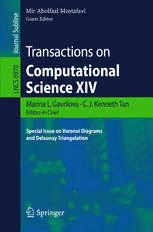Table Of ContentLecture Notes in Computer Science 6970
CommencedPublicationin1973
FoundingandFormerSeriesEditors:
GerhardGoos,JurisHartmanis,andJanvanLeeuwen
EditorialBoard
DavidHutchison
LancasterUniversity,UK
TakeoKanade
CarnegieMellonUniversity,Pittsburgh,PA,USA
JosefKittler
UniversityofSurrey,Guildford,UK
JonM.Kleinberg
CornellUniversity,Ithaca,NY,USA
FriedemannMattern
ETHZurich,Switzerland
JohnC.Mitchell
StanfordUniversity,CA,USA
MoniNaor
WeizmannInstituteofScience,Rehovot,Israel
OscarNierstrasz
UniversityofBern,Switzerland
C.PanduRangan
IndianInstituteofTechnology,Madras,India
BernhardSteffen
TUDortmundUniversity,Germany
MadhuSudan
MicrosoftResearch,Cambridge,MA,USA
DemetriTerzopoulos
UniversityofCalifornia,LosAngeles,CA,USA
DougTygar
UniversityofCalifornia,Berkeley,CA,USA
MosheY.Vardi
RiceUniversity,Houston,TX,USA
GerhardWeikum
MaxPlanckInstituteforInformatics,Saarbruecken,Germany
Marina L. Gavrilova C.J. Kenneth Tan
Mir Abolfazl Mostafavi (Eds.)
Transactions on
Computational
Science XIV
Special Issue on Voronoi Diagrams
and Delaunay Triangulation
1 3
Editors-in-Chief
MarinaL.Gavrilova
UniversityofCalgary,DepartmentofComputerScience
2500UniversityDriveN.W.,Calgary,AB,T2N1N4,Canada
E-mail:[email protected]
C.J.KennethTan
ExascalaLtd.
Unit9,97RickmanDrive,BirminghamB152AL,UK
E-mail:[email protected]
GuestEditor
MirAbolfazlMostafavi
UniversitéLaval
CentredeRechercheenGéomatique
Départementdessciencesgéomatiques
Québec,QC,G1V0A6,Canada
E-mail:[email protected]
ISSN0302-9743(LNCS) e-ISSN1611-3349(LNCS)
ISSN1866-4733(TCOMPSCIE) e-ISSN1866-4741(TCOMPSCIE)
ISBN978-3-642-25248-8 e-ISBN978-3-642-25249-5
DOI10.1007/978-3-642-25249-5
SpringerHeidelbergDordrechtLondonNewYork
LibraryofCongressControlNumber:2011940218
CRSubjectClassification(1998):I.3.5,F.2,G.2,E.1,I.4,I.5
©Springer-VerlagBerlinHeidelberg2011
Thisworkissubjecttocopyright.Allrightsarereserved,whetherthewholeorpartofthematerialis
concerned,specificallytherightsoftranslation,reprinting,re-useofillustrations,recitation,broadcasting,
reproductiononmicrofilmsorinanyotherway,andstorageindatabanks.Duplicationofthispublication
orpartsthereofispermittedonlyundertheprovisionsoftheGermanCopyrightLawofSeptember9,1965,
inistcurrentversion,andpermissionforusemustalwaysbeobtainedfromSpringer.Violationsareliable
toprosecutionundertheGermanCopyrightLaw.
Theuseofgeneraldescriptivenames,registerednames,trademarks,etc.inthispublicationdoesnotimply,
evenintheabsenceofaspecificstatement,thatsuchnamesareexemptfromtherelevantprotectivelaws
andregulationsandthereforefreeforgeneraluse.
Typesetting:Camera-readybyauthor,dataconversionbyScientificPublishingServices,Chennai,India
Printedonacid-freepaper
SpringerispartofSpringerScience+BusinessMedia(www.springer.com)
LNCS Transactions on Computational Science
Computational science, an emerging and increasingly vital field, is now widely
recognized as an integral part of scientific and technical investigations, affecting re-
searchersandpractitionersinareasrangingfromaerospaceandautomotiveresearchto
biochemistry, electronics, geosciences, mathematics, and physics. Computer systems
researchandtheexploitationofappliedresearchnaturallycomplementeachother.The
increased complexity of many challenges in computational science demands the use
ofsupercomputing,parallelprocessing,sophisticatedalgorithms,andadvancedsystem
softwareand architecture.Itis thereforeinvaluableto haveinputby systemsresearch
expertsinappliedcomputationalscienceresearch.
Transactions on Computational Science focuses on original high-quality research
in the realm of computational science in parallel and distributed environments, also
encompassingtheunderlyingtheoreticalfoundationsandtheapplicationsoflarge-scale
computation.Thejournalofferspractitionersandresearchersthe opportunityto share
computationaltechniquesandsolutionsinthisarea,toidentifynewissues,andtoshape
future directions for research, and it enables industrial users to apply leading-edge,
large-scale,high-performancecomputationalmethods.
In additionto addressingvariousresearchand applicationissues, the journalaims
topresentmaterialthatisvalidated–crucialtotheapplicationandadvancementofthe
researchconductedinacademicandindustrialsettings.Inthisspirit,thejournalfocuses
onpublicationsthatpresentresultsandcomputationaltechniquesthatareverifiable.
Scope
The scope of the journal includes, but is not limited to, the following computational
methodsandapplications:
• AeronauticsandAerospace
• Astrophysics
• Bioinformatics
• ClimateandWeatherModeling
• CommunicationandDataNetworks
• CompilersandOperatingSystems
• ComputerGraphics
• ComputationalBiology
• ComputationalChemistry
• ComputationalFinanceandEconometrics
• ComputationalFluidDynamics
• ComputationalGeometry
VI LNCSTransactionsonComputationalScience
• ComputationalNumberTheory
• ComputationalPhysics
• DataStorageandInformationRetrieval
• DataMiningandDataWarehousing
• GridComputing
• Hardware/SoftwareCo-design
• High-EnergyPhysics
• High-PerformanceComputing
• NumericalandScientificComputing
• ParallelandDistributedComputing
• ReconfigurableHardware
• ScientificVisualization
• Supercomputing
• System-on-ChipDesignandEngineering
Editorial
The Transactions on Computational Science journal is part of the Springer series
LectureNotesinComputerScience,andisdevotedtothegamutofcomputationalsci-
enceissues,fromtheoreticalaspectstoapplication-dependentstudiesandthevalidation
ofemergingtechnologies.
Thejournalfocusesonoriginalhigh-qualityresearchintherealmofcomputational
science in parallel and distributed environments, encompassing the facilitating theo-
retical foundationsand the applicationsof large-scalecomputationsand massive data
processing.Practitionersandresearcherssharecomputationaltechniquesandsolutions
in the area, identify new issues, and shape future directions for research, as well as
enableindustrialuserstoapplythetechniquespresented.
Thecurrentvolume,editedbyMirAbolfazlMostafavi,isdevotedtoVoronoiDia-
gramsandDelaunayTriangulation.Itiscomprisedofextendedversionsofninepapers,
carefullyselectedfromthepaperspresentedattheInternationalSymposiumonVoronoi
Diagrams, Quebec City, Canada, June 28–30, 2010. It also contains a Guest Editor’s
EditorialwithreflectionsonthehistoricalbackgroundoftheVoronoidiagram.
WewouldliketoextendoursincereappreciationtotheSpecialIssueGuestEditor
MirAbolfazlMostafaviforhisdedicationtopreparingthishigh-qualityspecialissue,
toallauthorsforsubmittingtheirpapers,andtoallAssociateEditorsandrefereesfor
theirvaluablework.WewouldalsoliketoexpressourgratitudetotheLNCSeditorial
staffofSpringer,inparticularAlfredHofmann,UrsulaBarth,andAnnaKramer,who
supportedusateverystageoftheproject.
It is our hope that the fine collection of papers presented in this issue will be a
valuableresourceforTransactionsonComputationalSciencereadersandwillstimulate
furtherresearchintothevibrantareaofcomputationalscienceapplications.
July2011 MarinaL.Gavrilova
C.J.KennethTan
Voronoi Diagrams and Delaunay Triangulation
Guest Editor’s Preface
TheVoronoidiagramisaconceptthathasbeenaroundforalongtime.In“Lemonde
deM.Descartesetletraite´ delalumie`re”publishedin1644,DescartesusedVoronoi-
likediagramstoshowthedispositionofmatterinthesolarsystemanditssurroundings.
However,the firstpresentationofthe conceptofthe Voronoidiagramappearedinthe
workofDirichlet(1850)andwasnamedaftertheRussian mathematicianGeorgyFe-
doseevich Voronoi (or Voronoy), who defined and studied the general n-dimensional
case in 1908. Since then, several extensions have originated from these publications.
ThefirstextensiontotheVoronoidiagramwasincrystallography,whereasetofpoints
was placed regularly in space and the Voronoi cells were labeled as Wirkungsberich
(area of influence) (Niggli, 1927). Thiessen (1911) used Voronoi regions, which are
referred to as Thiessen polygons, to compute accurate estimates of regional rainfall
averages.AnotherextensionoftheVoronoidiagramwasseeninnaturalandsocialsci-
ences for studying marketareas (Bogue 1949).The Voronoidiagram in geographyis
usedto analyze2D pointpatterns(Boots,1974).Itwas onlyinthe early1970sthata
numberofalgorithmsfortheefficientconstructionoftheVoronoidiagramweredevel-
oped.Thismotivatedfurtherdevelopmentsinseveralareasusingcomputerscienceand
computationalgeometry.
Voronoi diagrams continue to be developed and their applications are expanding
fromnaturalsciencestoengineeringandfrommedicalsciencestosocialsciences.This
special issue of the journal Transactions on Computational Science is devoted to the
latestadvancesinVoronoidiagramsandtheirapplicationsinsciencesandengineering.
Itpresentsacollectionofthebestpapersthatwereselectedfromthepaperspresented
duringthe7thInternationalSymposiumonVoronoiDiagramsandtheirapplicationsin
sciences and engineering.This edition of the symposium, which was chaired by Mir
AbolfazlMostafavi,ProfessorattheDepartmentofGeomaticsandtheDirectorofthe
CentreforResearch inGeomaticsatLavalUniversity,wasorganizedin QuebecCity,
Canada and was sponsored by the Center for Research in Geomatics (CRG), Laval
UniversityandtheGEOIDEnetworksofCentresofExcellence.
This special issue presents nine selected papers presented during the symposium.
Thepaperswereextendedbytheauthorsandpassedthroughtworoundsofreviewing
beforepublication.Severalinterestingtopicsarediscussedinthisissuewhichinclude:
– DevelopmentofnewgeneralizedVoronoidiagramsandalgorithmsincludinground-
tripVoronoidiagrams,maximalzonediagrams,Jensen-BregmanVoronoidiagrams,
hyperbolicVoronoidiagrams,andmovingnetworkVoronoiDiagrams.
– New algorithms based on Voronoi diagrams for applications in sciences and
engineering, including geosensor networks deployment and optimization and
homotopicobjectreconstruction
– Application of Delaunay triangulation for the modeling and representation of
CosmicWebandrainfalldistribution.
X GuestEditor’sPreface
The editor expects that readers of the Transactions on Computational Science (TCS)
will benefit from the papers presented in this special issue on the latest advances in
Voronoi diagrams and Delaunay triangulation and their applications in sciences and
engineering.
Acknowledgment
TheguesteditorofthisSpecialIssueonVoronoiDiagramsandDelaunayTriangulation,
Transactions on Computational Science (TCS), Vol. XIV, would like to thank all the
authorsfor preparingand submitting originalcontributionsfor this special issue. The
guest editor is also grateful to the Program Committee members of ISVD 2010, as
wellasthereviewers,fortheirgreatcontribution.Specialthanksgotothemembersof
the Steering Committee of ISVD 2010for their valuable help and supportduringthe
preparationofthisspecialissue.TheEditor-in-ChiefofTCS,Dr.MarinaL.Gavrilova,
alsodeservesspecialthanksforheradvice,vision,andsupport.Finally,theprofessional
helpandcommitmentofthePublisherSpringerisgreatlyacknowledged.
July2011 MirAbolfazlMostafavi
GuestEditor
LNCS Transactions on Computational
Science – Editorial Board
MarinaL.Gavrilova,Editor-in-chief UniversityofCalgary,Canada
ChihJengKennethTan,Editor-in-chief OptimaNumerics,UK
TetsuoAsano JAIST,Japan
BrianA.Barsky UniversityofCaliforniaatBerkeley,USA
AlexanderV.Bogdanov InstituteforHighPerformanceComputing
andDataBases,Russia
MartinBuecker AachenUniversity,Germany
RajkumarBuyya UniversityofMelbourne,Australia
HyungseongChoo SungkyunkwanUniversity,Korea
DannyCrookes Queen’sUniversityBelfast,UK
TamalDey OhioStateUniversity,USA
IvanDimov BulgarianAcademyofSciences,Bulgaria
MagdyEl-Tawil CairoUniversity,Egypt
OsvaldoGervasi Universita`degliStudidiPerugia,Italy
ChristopherGold UniversityofGlamorgan,UK
RodolfoHaber CouncilforScientificResearch,Spain
AndresIglesias UniversityofCantabria,Spain
Deok-SooKim HanyangUniversity,Korea
IvanaKolingerova UniversityofWestBohemia,CzechRepublic
VipinKumar ArmyHighPerformanceComputingResearchCenter,USA
AntonioLagana Universita`degliStudidiPerugia,Italy
D.T.Lee InstituteofInformationScience,AcademiaSinica,Taiwan
LaurenceLiew PlatformComputing,Singapore
NikolaiMedvedev NovosibirskRussianAcademyofSciences,Russia
GrahamM.Megson UniversityofReading,UK
EdwardD.Moreno UEA–UniversityofAmazonasstate,Brazil
YoungsongMun SoongsilUniversity,Korea
DimitriPlemenos Universite´deLimoges,France
ViktorK.Prasanna UniversityofSouthernCalifornia,USA
MuhammadSarfraz KFUPM,SaudiArabia
DaleShires ArmyResearchLab,USA
MashaSosonkina AmesLaboratory,USA
AlexeiSourin NanyangTechnologicalUniversity,Singapore
DavidTaniar MonashUniversity,Australia
AthanasiosVasilakos UniversityofWesternMacedonia,Greece
CheeYap NewYorkUniversity,USA
IgorZacharov SGIEurope,Switzerland
ZahariZlatev NationalEnvironmentalResearchInstitute,Denmark
Table of Contents
RevisitingHyperbolicVoronoiDiagramsinTwoandHigherDimensions
fromTheoretical,AppliedandGeneralizedViewpoints ................... 1
ToshihiroTanuma,HiroshiImai,andSonokoMoriyama
MollifiedZoneDiagramsandTheirComputation ........................ 31
SergioC.deBiasi,BahmanKalantari,andIrajKalantari
Alpha, Betti and the Megaparsec Universe: On the Topology of the
CosmicWeb ..................................................... 60
Rien van de Weygaert, Gert Vegter, Herbert Edelsbrunner,
Bernard J.T. Jones, Pratyush Pranav, Changbom Park,
Wojciech A. Hellwing, Bob Eldering, Nico Kruithof,
E.G.P. (Patrick) Bos, Johan Hidding, Job Feldbrugge,
Eline ten Have, Matti van Engelen, Manuel Caroli, and
MoniqueTeillaud
SkewJensen-BregmanVoronoiDiagrams .............................. 102
FrankNielsenandRichardNock
Continuous-TimeMovingNetworkVoronoiDiagram..................... 129
ChenglinFan,JunLuo,andBinhaiZhu
A GIS Based Wireless Sensor Network Coverage Estimation and
Optimization:AVoronoiApproach ................................... 151
Meysam Argany, Mir Abolfazl Mostafavi, Farid Karimipour, and
ChristianGagne´
RainfallDistributionBasedonaDelaunayTriangulationMethod ........... 173
NicolasVelasquez,VeronicaBotero,andJaimeIgnacioVelez
HomotopicObjectReconstructionUsing NaturalNeighborBarycentric
Coordinates...................................................... 188
OjaswaSharmaandFranc¸oisAnton
Round-Trip Voronoi Diagrams and Doubling Density in Geographic
Networks........................................................ 211
MatthewT.Dickerson,MichaelT.Goodrich,ThomasD.Dickerson,and
YingDaisyZhuo
AuthorIndex .................................................... 239

